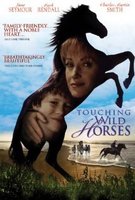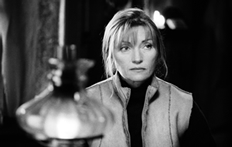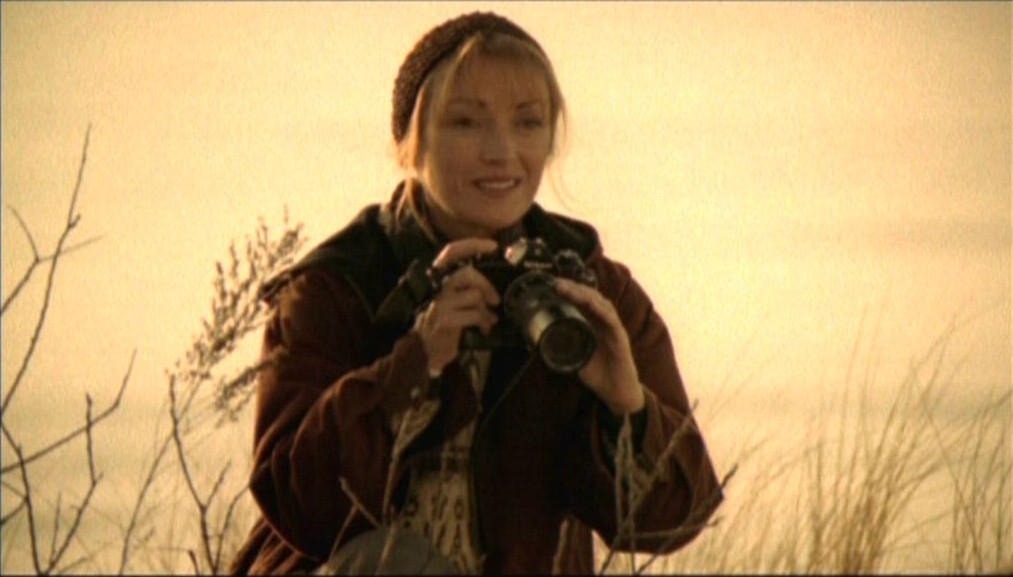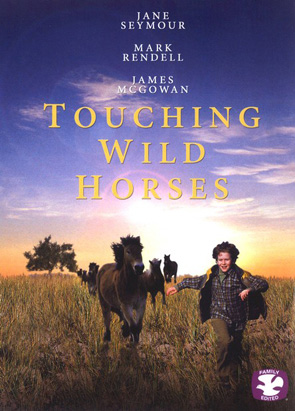
Image 1: DVD Cover Image
Eleanore Lindo’s 2002 film, Touching Wild Horses, tells the story of a young boy named Mark (Mark Rendall), who is sent to live with his aunt Fiona (Jane Seymour) after a tragic car accident kills Mark’s father and sister and puts his mother in a coma. On Sable Island, both characters find comfort in the wild horses that populate the area. In the film, the horses become modes of healing for Fiona, but especially for Mark. The time that Fiona spends with the horses allows her to overcome the tragedy of having to give up her son, while Mark’s connection with a foal he names John as well as his subconscious interaction with wild horses help him deal with the loss of his father and sister.

Image 2: Fiona as the “protagonist”
Following the traumatic experience of having to give her son away, Fiona moves to Sable Island to escape the embarrassment she has caused her family by having a baby at a young age and, since then, the time she spends alone surrounded by the wild horses helps her cope with the loss of her son. Throughout the film, Fiona finds comfort in the horses that populate Sable Island. Every interaction she has with them is uplifting and allows her to gain a sense of peace. She states that over the years, “the horses have become [her] family” and her support system (56:46-57:10). A scene that illustrates the therapeutic effect that the wild horses have on Fiona is the one in which she photographs them (16:41-17:33). Before this scene, the film focuses on the tension between Fiona and Mark. Fiona is depicted as a strict caretaker, who assigns homework to Mark and who criticizes his lack of grammar and vocabulary skills. The film’s writer, Murray McRae, explains that he wished to portray Fiona as the antagonist of Mark’s story by emphasizing the distance she keeps from him and by including several scenes in which she belittles Mark [3] (See Figure 2). However, the scene in which Fiona photographs the wild horses is a turning point for her character. In fact, this is the first interaction we see between Fiona and the wild horses and, most importantly, it is the first time that Fiona smiles in the film (See Figure 3). As she observes the horses and takes pictures of them, she seems happy, which contrasts with the negative energy she displays up to this point. This scene demonstrates the positive impact that the horses have on Fiona, since her interaction with them results in her change in mood and allows her to let go of the emotional burden that she has carried since the beginning of the film. Fiona eventually opens up about this emotional burden to Mark and explains that her hostility is the result of having to give her son away.

Image 3: Fiona smiling as she photographs the wild horses

Image 4: Mark petting John
Furthermore, Mark’s relationship with a foal named John helps him deal with the tragic loss of his father and sister. Following the night of the hurricane, Fiona and Mark find a foal whose mother got stuck in a fisher’s net and drowned during the storm (45:50). Mark expresses his interest in the foal and feels the need to help it. Although Fiona forbids him from taking care of the foal, he sneaks out at night and breaks Fiona’s first rule: do not feed or touch the wild horses (44:25-47:30) (See Figure 4). The striking similarity between Mark’s story and John’s story—both have suffered the tragic loss of a parent— brings these two characters together. The fact that Mark feels the need to break the rules and develop a friendship with John suggests his need to connect with another creature that is facing similar struggles. In a sense, Mark and John need each other to get through this difficult time. Mark helps John by giving him food and water, since the foal was dependent of his mother before losing her. By taking care of John, Mark finds a purpose, which allows him to break away from his constant focus on the night of the car accident. Hence, Mark’s connection with John plays a key role in his healing process.

Image 5: Mark running away from the wild horses
Mark’s subconscious interaction with the wild horses, especially the dark horse that appears in his last nightmare, also helps him overcome his guilt and begin his healing process. Although the film contains numerous light-hearted scenes that showcase the flourishing of Mark and Fiona’s relationship, as well as Mark’s friendship with John, the film incorporates some darker scenes that allow “psychologically complex stories” to develop [1]. For instance, since the night of the car accident that resulted in the death of his father and his sister, Mark has recurring nightmares in which he is haunted by his family’s cries, the sound of a siren and the image of an abandoned car. In his last nightmare, Mark chases a black horse ridden by a horseman wearing a long black cloak (58:00-59:15). In this particular scene, the black horse and its rider take on the symbolism of death that many cultures associate with these images. For instance, in Ireland, death is personified as the “dullahan”, a horseman with a long black cape who travels from one family home to another on a black horse to announce the upcoming death of an individual [2]. In Mark’s nightmare, the black horse and its rider symbolize the death of Mark’s father and sister, which is further exemplified when in the dream the horse runs past the graveyard in which his family has been put to rest. The dominance of cold colors in this scene—such as the shades of blues in the sky, in the water, and on the sand surrounding the black horse and the horseman—emphasizes the coldness associated with death. Furthermore, the haunting undertones of the music playing in the background add to the darkness of the nightmare. Thus, Mark’s contact with the wild horses is not limited to the physical interactions he has with them; the fact that his nightmares—inextricably connected to the healing process— constantly involve horses highlights his subconscious connection to them.
According to McRae, Mark’s last nightmare is crucial to his healing process since it pushes him to open up to his aunt Fiona about the guilt that he feels since the night of the car accident [3]. In his previous nightmares, Mark runs away from the black horse, which represents his subconscious fear of death and illustrates the psychological trauma that the loss of his father and sister has caused him (See Figure 5). However, in his last nightmare, Mark chases the horseman and the black horse, which suggests that Mark is chasing death. The fact that Mark runs towards death in his dream demonstrates his attempt to try to reach it and to somehow stop it, and his failure to do so illustrates the responsibility he takes in his father and sister’s deaths. It is only once Mark has this nightmare that he tells Fiona about the psychological distress that the loss of his loved ones has caused him, about the guilt that he feels for running away from home on the night of the accident, and about wishing that he, too, were dead. Hence, this nightmare is a turning point in the film since it is through Mark’s encounter with death, personified by the black horse and its rider that he openly admits to feeling responsible for the deaths in his family. This acknowledgment allows Mark to let go of his guilt and begin his healing process.
In conclusion, in the film, the horses represent modes of healing for the characters. Fiona’s interactions with the wild horses allow her to overcome the emotional burden of having to give her son away; on the other hand, Mark’s connection with John helps him heal since it allows him to shift his focus away from the night of the car accident, while his subconscious interactions with the wild horses, especially the dark horse in his final nightmare, pushes him to open up to Fiona about his guilt and continue his healing process.
Sources:
[1] Touching Wild Horses: From the Director, An Interview with Director Eleanore Lindo: http://www.touchingwildhorses.com/pages/touchingwildhorseseleanorinterview.htm [accessed 8 November 2015]
[2] Death (Personification): https://en.wikipedia.org/wiki/Death_(personification) [accessed 7 November 2015]
[3] Touching Wild Horses: The Writer Speaks, An Interview with Writer Murray McRae: http://www.touchingwildhorses.com/pages/touchingwildhorsesmurraymcraeinterview.htm[accessed 8 November 2015]
DVD Cover Image. 2002. Web. 2 Dec. 2015.(http://ia.media-imdb.com/images/M/MV5BMTM4MjU5OTk4OV5BMl5BanBnXkFtZTcwNjc2MTgyMQ@@._V1_SY317_CR4,0,214,317_AL_.jpg)
Fiona as the “antagonist”. 2002. Web. 1 Dec. 2015.(http://www.touchingwildhorses.com/images/janeblackandwhitesmall.jpg)
Fiona smiling as she photographs the wild horses. 2002. Web. 3 Dec. 2015.(http://images2.fanpop.com/image/photos/10000000/Touching-Wild-Horses-jane-seymour-10075493-1013-577.jpg)
Mark petting John. 2002. Web. 2 Dec. 2015. (http://img.deseretnews.com/images/g/location/1/1813002.jpg)
Mark running away from the wild horses. 2002. Web. 3 Dec. 2015. (http://www.christiancinema.com/catalog/images/WildHorses_dvd_lg.jpg)
Touching Wild Horses. Canada: Eleanore Lindo, 2002. DVD.